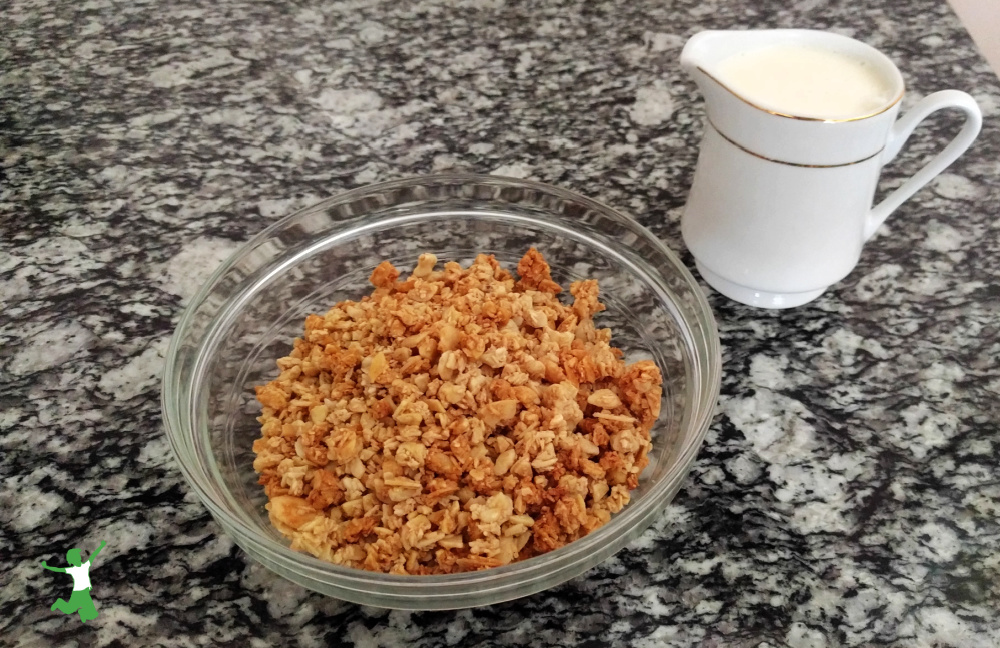The shocking truth about the processing that is required to make boxed breakfast cereal which makes it toxic even if organically certified.

Did you know that ALL boxed breakfast cereals are toxic?
In fact, organic boxed breakfast cereal is the most toxic of all!
How can this be?
It seems that everywhere you turn, a bowl of breakfast cereal is touted as a very healthy choice for your first meal of the day.
It’s not true, folks!
To make boxed breakfast cereal in the factory, the grains first have to be subjected to such intense pressure and heat that they actually liquefy into a slurry.
This slurry allows the grains to be quickly and easily shaped into the puffs, flakes, and other shapes that make each cereal distinct.
The manufacturing process used to make boxed cereal is called extrusion.
It is so violent and denaturing that the proteins in the grains are actually rendered toxic and allergenic by the process.
This is why organic boxed breakfast cereal is more toxic than nonorganic.
Organic boxed cereal is whole grain and has significantly more protein in it!
In other words, the more protein, the more toxic the boxed cereal.
The digestive system has no idea how to metabolize these warped, denatured protein molecules.
The undigested food particles putrefy in the gut. They are also food for pathogens to feed upon, which serves to strengthen them and crowd out good flora.
Stay away!
If you wish to eat cold breakfast cereal that is healthy, you must make your own.
Here are 7 homemade cereal recipes to try and enjoy to wean yourself off an unhealthy and addictive boxed cereal habit.
More Information
How to Adjust to the Taste of Soaked Oatmeal
Soaked Oatmeal Benefits Without the Soaking?
How to Make Oatmeal the RIGHT Way
Reference








That’s a TON of work just to make something so bland and injuring as cereal!
Thank you for this article. I usually buy the cascadian farms oats, convinced that it was healthy. Non GMO, Organic, etc. So after reading your article, I called the manufacturer (General Mills, go figure) explained in depth about why I’m calling, read sections of your article to her, and basically just going straight to the source to verify the info I read. She put me on hold for several minutes and said “I cannot discuss this with you, it is confidential”. I asked her “what can you not discuss?” she said “everything, all of your questions, I cannot discuss this”. So I told her thank you, and that she just answered my questions, and I will not be purchasing this cereal anymore. They have a lot to hide. Big business marketing to kids! Thanks again for your post. I learned something new today!
What about ezekiel cereal, air know it’s not soaked but is it at least a bit better than the other stuff?
Doesn’t that cereal have soy in it? If so, definitely a no go. I personally wouldn’t eat it. Whole grain boxed cereal is the worst as discussed in the article.
All cerals, grains and sugars are toxic. Fruit too. Don’t kid yourself. Any carbs turn right into sugar and have to be processed by the liver or pancreas. Do you know where your pancreas is and how little and thin it is? Human insulin, required to break down sugars into glucose is a toxin and creates heart disease, dementia and cancer. Atkins, paleo and South Beach are the way to go. 0 carbs per meal, 15 total per day for a month long cleanse and then no more than 15 per meal after that. are you kidding?
What about puffed rice cereal or Lumberg rice cake? Are those toxic also? Or popcorn?
Puffed rice is toxic also. Sorry to be the bearer of bad news!
Here is his response, What do you say?
First, you denature proteins when you heat food above 40 degrees or so. So all your vegetables cooked in water, meat, and egg dishes contain denatured proteins. The fear from denatured proteins is similar to the fear of DNA in the flowers growing in your back garden.
You then mention glycation products (AGPs). These are products of non-enzymatic reactions between proteins and sugars, and are indeed thought to be rather unhealthy. Here’s a paper with a lot of information on them:
https://www.ncbi.nlm.nih.gov/pmc/articles/PMC3704564/
Among other things, the paper has a table for the glycation products from a number of foods, and here are two selected numbers:
olive oil, extra virgin, cold pressed: about 500 kU/serving (of 5 g), while raisin bran (Kellogs) has 10 kU/serving (of 30 g). In fact, when you go over the table, cereals are certainly the least serious source of glycation products on the list. Also, the difference in the amount of AGPs between regular olive oil and the cold-pressed one is about 10% – a small difference, but still 5 times more than the total amount of AGPs in cereals (even taken portion-wise, as I did).
Then you mention Furosine. I couldn’t find any discussion of health damage from Furosine – it is a glycation product derived from the amino acid lysine, and has been researched extensively, but seems mostly to be used as an indicator, since it is presumably easy to measure its quantity in food. It doesn’t seem to have any separate status as a health hazard. One specific point about furosine is that lysine is an essential amino acid, and higher amount of furosine indeed indicate less lysine availability from the food. But the numbers are not very large – maybe half the lysine gets converted to furosine under extreme conditions.
Finally, it turns out that the glycation products are actually considered as ‘good’ in some circumstances – for example, they have antioxidant activity.
Last but not least – extrusion. This is a process widely used to make food – not only cereals but also pasta. Generally, any food that you eat and that had a shape give by humans rather than nature was produced by extrusion. As far as I know, you give pasta to the kids. Extrusion is not a single process, but a family of processes whose effect on food depends on multiple parameters. The mechanical aspects of the extrusion process certainly don’t denature proteins (as implied by your message) – this is done by heating. AGP production also depends a lot on the conditions in which the process works. This is true for any process used to make food.
Finally, look at the huge distance there is between the evidence that you bring and the consequences you infer from it. What you have is a list of quantitative issues (extrusion increases significantly one thing or another; it may influence the level of AGPs; it may affect the level of lysine that is actually available to the body). None of these is extremely serious by itself, and as I found out that AGPs are actually substantially less present in cereals than in other foods. Nevertheless you infer that morning cereals are toxic.
So – all smoke and no fire.
Hi Sarah,
Need some help here. I sent this article to my ex who is now feeding junk to kids all the time after they had been in a nourishing tradition diet all of their lives . He replied “Saying it is toxic does not mean it is toxic. Here let me state :Boxed Breakfast Cereal is So Healthy!”
I wrote the following :
she explained that extreme heat and pressure are applied to grains denaturing their protein and thus rendering it toxic.
That process of extreme heat and pressure is called Extrusion and it enables mass production of food, so extruded food = processed food .
When you think about it at a chemical level, it’s more than a bit naïve to assume that foods can be taken from their fresh state, heated to extremely high temperatures, exposed to chemical and physical processing, spray dried, and left to sit on a store shelf for many months (if not years), and still maintain the beneficial nutritional properties of the fresh food.
The extrusion process results in chemical reactions that have the following effects:
Reduction of microorganisms in the final product (for good and for bad)
Slight increase of iron-bioavailability
Creation of insulin-desensitizing starches (a potential risk-factor for developing diabetes)
Loss of lysine, an essential amino acid necessary for developmental growth and nitrogen management
Simplification of complex starches, increasing rates of tooth decay
Increase of glycemic index of the processed food, as the “extrusion process significantly increased the availability of carbohydrates for digestion”
Destruction of Vitamin A (beta-carotene)
Denaturation of proteins.
Extrusion may change carbohydrates, dietary fibre, the protein and amino acid profile, vitamins, and mineral content of the extrudate in a manner that can be beneficial ( microorganiss are killed) , or harmful if high temperature and pressure are used . (like in the case of boxed cereals)
Why? because high temperatures and pressure cause the fragmentation of proteins, starches, and non-starch polysaccharides that create reactive molecules that may form new linkages not found in nature. This includes Maillard reactions which reduce the nutritional value of the proteins or destruction of vitamins
According to Shivendra Singh, Shirani Gamlath*andLara Wakeling, in Nutritional aspects of food extrusion: a review, a negative effect has been found on nutritional quality of the extrudate with a high temperature and low moisture (less than 15%) like in the case of boxed cereals.
Is that clearer or do you need me to expand more?
About DENATURATION of proteins :
Denatured proteins are ALTERED protein structures, that can be produced BOTH in ur foods and in our bodies. Those altered proteins are also called GLYCATION PRODUCTS ( when the chemical changes proceed far enough they are called advanced glycation endproducts or AGEs) . Various glycation products have been found CONSISTENTLY elevated in the body under conditions of disease and aging . And by the way, a partucular glycation product called furosine, has been found elevated in patients with ALzheimers
Similar to the glycation phenomenon which occurs in the body under conditions of aging or disease , certain types of food processing result in the production of high amounts of furosine in some food like… tata, BREAKFAST CEREALS!!
quote from study Lysne availability is diminished in commercial fibre-enriched breakfast cereals:
Furosine is a heat–induced marker for thermal treatment in foodstuffs and is directly related to the loss of lysine availability…Data showed a statistically significant effect of protein content, added–dietary fibre and physical form of the samples (flakes/puffed) on the level of furosine present in commercial breakfast cereals. The higher the protein content in the formulation, the higher were the furosine levels, regardless of the protein source. Significantly higher furosine levels were found in puffed commercial breakfast cereals.
Eating these denatured proteins and glycation products has been shown to add to the AGE burden, may be particularly detrimental to kidney function, and to cause a major increase in systemic inflammation – including inflammatory disease markers such as C–reactive protein, even in healthy subjects.
Why is denatured protein toxic? Doesn’t the body denature the proteins once ingested?
Denaturing means that the proteins won’t fit together with enzymes to digest them any longer. When food cannot be digested, it causes digestive imbalance and allergenic issues over time.
Good to go, Happy Anniversary……..
I can’t believe it has been 5 year already!!!